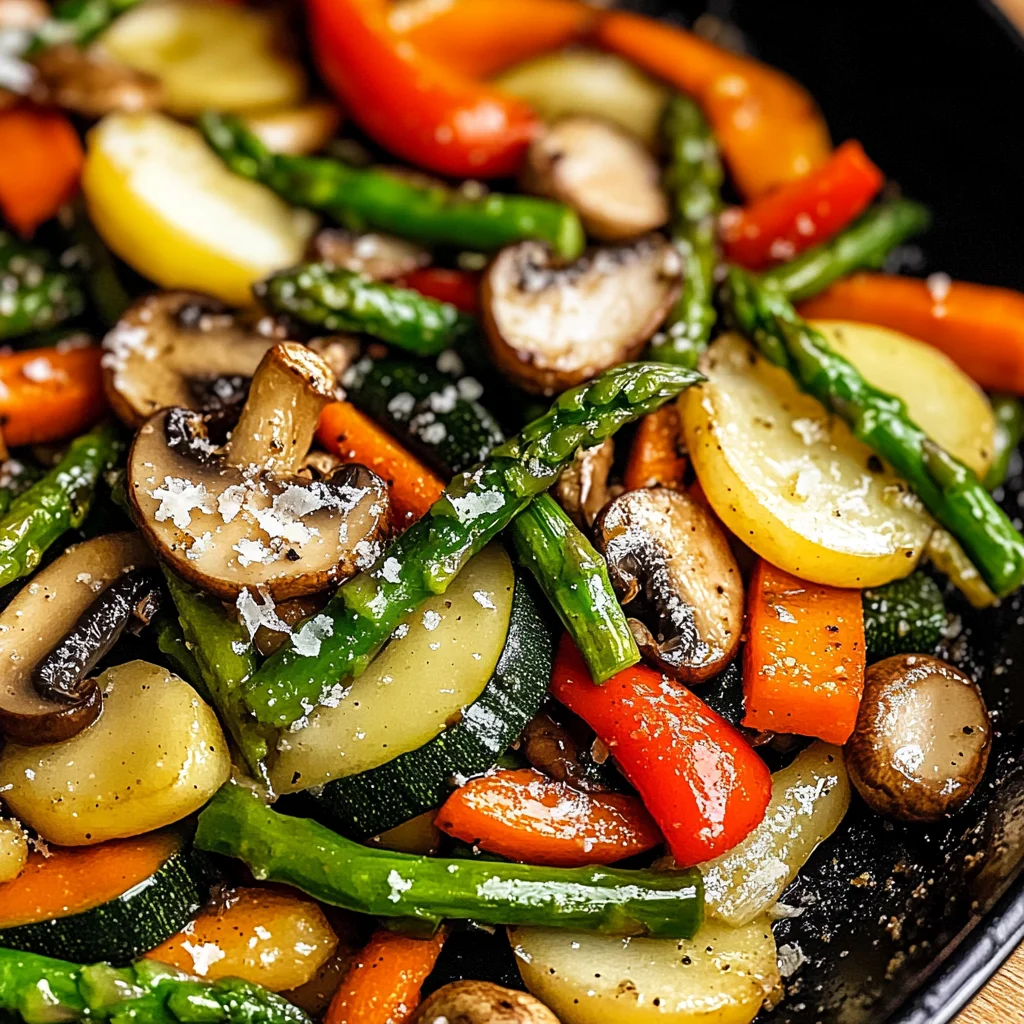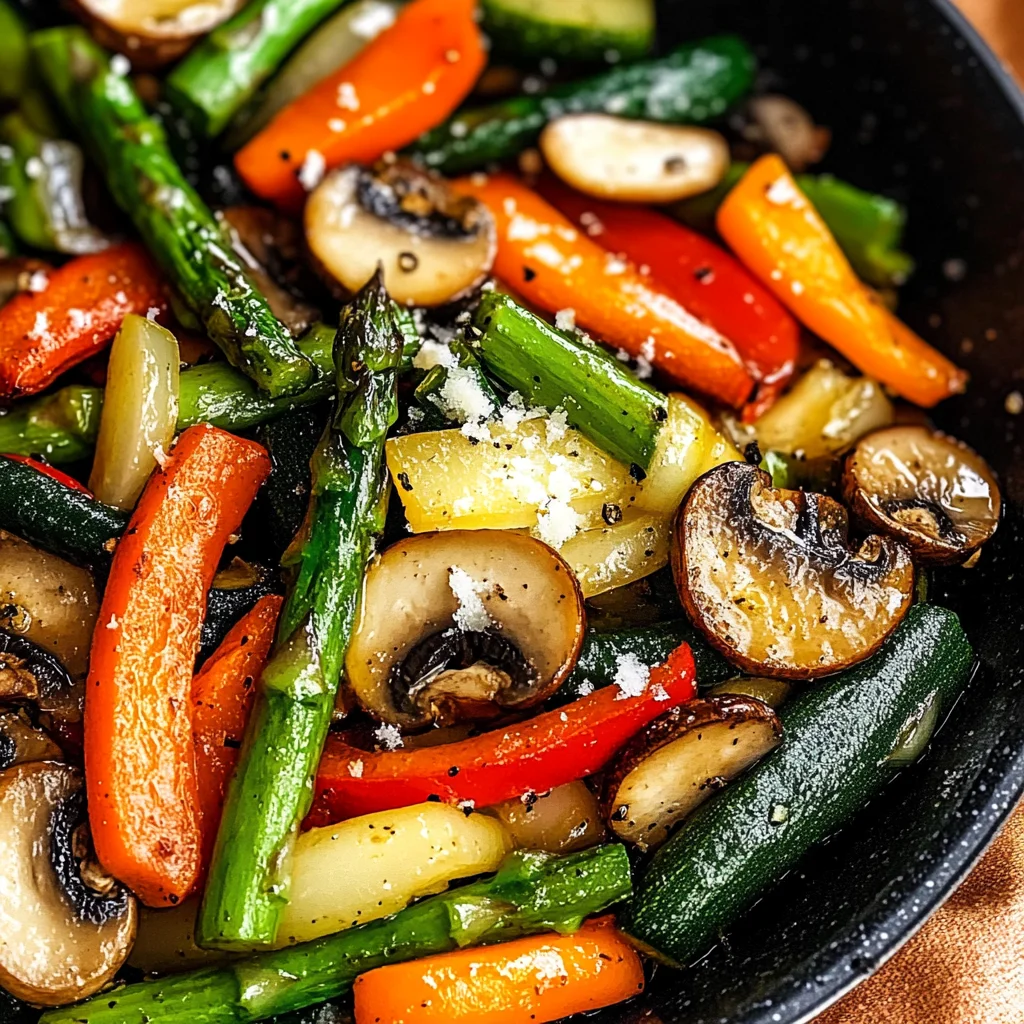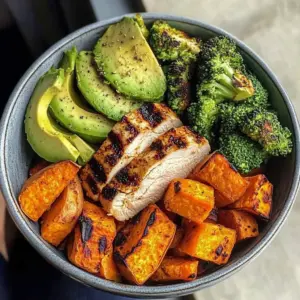Before diving into the delightful world of sautéed vegetables, you’ll find that this Healthy Sauteed Vegetables Recipe is not only quick to prepare but also bursting with flavor. Perfect for any occasion, from weeknight dinners to festive gatherings, these vibrant vegetables bring a nutritious and satisfying side dish to your table. The combination of fresh ingredients and aromatic spices creates a dish that is both healthy and delicious.

Jump to:
- Why You’ll Love This Recipe
- Tools and Preparation
- Essential Tools and Equipment
- Importance of Each Tool
- Ingredients
- For the Vegetables
- For Seasoning
- How to Make Healthy Sauteed Vegetables Recipe
- Step 1: Prep Your Vegetables
- Step 2: Heat the Oil
- Step 3: Sauté Garlic
- Step 4: Add Carrots
- Step 5: Incorporate Asparagus and Zucchini
- Step 6: Mix in Bell Peppers and Mushrooms
- Step 7: Season It Up
- Step 8: Finishing Touches
- How to Serve Healthy Sauteed Vegetables Recipe
- As a Standalone Dish
- Over Quinoa or Rice
- In a Wrap
- As a Topping for Grilled Chicken
- Mixed into Pasta
- With an Egg Dish
- How to Perfect Healthy Sauteed Vegetables Recipe
- Best Side Dishes for Healthy Sauteed Vegetables Recipe
- Common Mistakes to Avoid
- Storage & Reheating Instructions
- Refrigerator Storage
- Freezing Healthy Sauteed Vegetables Recipe
- Reheating Healthy Sauteed Vegetables Recipe
- Frequently Asked Questions
- What makes this a Healthy Sauteed Vegetables Recipe?
- Can I add other vegetables?
- How do I enhance flavors in my Healthy Sauteed Vegetables Recipe?
- Can I make this recipe vegan?
- Final Thoughts
- 📖 Recipe Card
Why You’ll Love This Recipe
- Quick Cooking Time: This recipe takes just 25 minutes from prep to plate, making it perfect for busy nights.
- Flavor-Packed: With garlic, herbs, and spices, every bite is bursting with rich flavors.
- Versatile Ingredients: Feel free to swap in whatever veggies you have on hand; it’s adaptable for seasonal produce.
- Health Benefits: Packed with nutrients, this dish provides vitamins and minerals while keeping calories low.
- Great for Meal Prep: Prepare a larger batch and enjoy leftovers throughout the week for easy meals.
Tools and Preparation
Having the right tools makes the cooking process smoother. Here are the essentials to prepare your sautéed vegetables.
Essential Tools and Equipment
- Large skillet
- Cutting board
- Sharp knife
- Measuring spoons
- Spatula or wooden spoon
Importance of Each Tool
- Large Skillet: A wide surface area ensures even cooking and browning of vegetables.
- Sharp Knife: Chopping vegetables finely helps them cook quickly and uniformly.
- Spatula or Wooden Spoon: Perfect for stirring without scratching your skillet’s surface.

Ingredients
Here’s what you’ll need for this delicious Healthy Sauteed Vegetables Recipe:
For the Vegetables
- 3 cloves of garlic (finely chopped)
- 1 cup of thinly sliced carrot rounds
- 1 pound of asparagus spears (woody ends removed, cut into 1-inch segments)
- 1 red bell pepper (thinly sliced into strips)
- 1 medium zucchini (cut into thin rounds)
- 8 ounces of fresh mushrooms (cleaned and sliced)
- 3 green onions (thinly sliced (both green and white parts))
For Seasoning
- 2 tablespoons extra-virgin olive oil
- 1/4 cup grated Parmesan cheese
- 1 tablespoon fresh lemon juice
- 1 teaspoon sea salt
- 1/2 teaspoon powdered onion
- 1/4 teaspoon freshly ground black pepper
- A pinch of crushed red pepper flakes
- 1/2 teaspoon dried Italian herb blend
- 1/4 teaspoon smoked paprika
How to Make Healthy Sauteed Vegetables Recipe
Step 1: Prep Your Vegetables
Make sure all your vegetables are washed, dried, and cut according to the specifications. You want them uniform for even cooking. Trust me, this little prep step makes a world of difference.
Step 2: Heat the Oil
In a large skillet, add the olive oil over medium-high heat. Wait until it shimmers. This indicates that it’s hot enough to start sautéing.
Step 3: Sauté Garlic
Add the chopped garlic and sauté for about 30 seconds, until fragrant. Don’t walk away—it burns fast!
Step 4: Add Carrots
Toss in those carrot rounds first since they take longer to cook. Stir frequently for about 2-3 minutes until they start to soften.
Step 5: Incorporate Asparagus and Zucchini
Next, add the asparagus spears and zucchini. Continue stirring for another 3-5 minutes until they are vibrant green and tender-crisp.
Step 6: Mix in Bell Peppers and Mushrooms
Now it’s time for the bell pepper strips and mushrooms. Toss them in and stir for another 2-3 minutes until vibrant but not mushy.
Step 7: Season It Up
Sprinkle in sea salt, cracked black pepper, powdered onion, crushed red pepper flakes, Italian herb blend, and smoked paprika. Stir well to meld the flavors together for about a minute.
Step 8: Finishing Touches
Remove the skillet from heat. Drizzle lemon juice on top and sprinkle with Parmesan cheese. Give it a gentle toss before serving.
Enjoy your delicious Healthy Sauteed Vegetables!
How to Serve Healthy Sauteed Vegetables Recipe
Sautéed vegetables are versatile and can enhance any meal. Here are some creative serving suggestions to elevate your dish.
As a Standalone Dish
- Enjoy the sautéed vegetables on their own for a light and healthy meal. They are packed with nutrients and flavor.
Over Quinoa or Rice
- Serve the sautéed vegetables over a bed of fluffy quinoa or brown rice. This adds a nice texture and makes it more filling.
In a Wrap
- Use whole wheat or spinach wraps to create a delicious veggie wrap. Add some hummus or tzatziki for extra flavor.
As a Topping for Grilled Chicken
- Place the sautéed vegetables on top of grilled chicken breast for a colorful and nutritious main course.
Mixed into Pasta
- Toss the sautéed veggies with your favorite pasta and a drizzle of olive oil for a hearty vegetarian meal.
With an Egg Dish
- Pair the vegetables with scrambled eggs or an omelet for a vibrant breakfast option that’s both satisfying and healthy.
How to Perfect Healthy Sauteed Vegetables Recipe
To achieve the best results with your sautéed vegetables, consider these helpful tips.
- Prep Ahead: Wash and cut all your vegetables before cooking. This ensures even cooking and saves time.
- Use High Heat: Cooking on medium-high heat allows for quick caramelization, bringing out the natural sweetness in your veggies.
- Don’t Crowd the Pan: Sauté in batches if necessary. Overcrowding can lead to steaming rather than sautéing.
- Add Ingredients in Stages: Start with harder vegetables like carrots, adding softer ones later. This helps maintain texture.
- Finish with Freshness: A squeeze of lemon juice at the end brightens up the flavors and adds freshness.
- Experiment with Herbs: Feel free to mix in different herbs or spices based on your preference for varied flavors each time you make this recipe.
Best Side Dishes for Healthy Sauteed Vegetables Recipe
Sautéed vegetables pair wonderfully with many side dishes, enhancing your overall meal experience. Here are some great options:
Garlic Mashed Potatoes
Creamy mashed potatoes infused with garlic provide a comforting contrast to sautéed veggies.Couscous Salad
A refreshing couscous salad mixed with cherry tomatoes, cucumbers, and herbs complements the veggies nicely.Roasted Sweet Potatoes
The natural sweetness of roasted sweet potatoes pairs perfectly with savory sautéed vegetables.Lentil Soup
A warm bowl of lentil soup can balance out the freshness of sautéed vegetables, making for a hearty combo.Grilled Fish
Lightly grilled fish like salmon or tilapia offers protein that works well alongside vibrant vegetable flavors.Chickpea Salad
A protein-rich chickpea salad seasoned with lemon and herbs makes for an excellent companion dish.Whole Grain Bread
Serve with slices of whole grain bread to soak up any juices from the vegetables, adding another layer of texture.Cauliflower Rice
For a low-carb option, serve alongside cauliflower rice seasoned lightly for additional flavor without heavy carbs.
Common Mistakes to Avoid
Sautéing vegetables may seem simple, but small mistakes can affect the taste and texture. Here are some common pitfalls to watch out for.
- Skipping the prep work: Cutting vegetables unevenly can lead to inconsistent cooking. Always wash, dry, and slice your veggies uniformly for even results.
- Overcrowding the pan: Adding too many vegetables at once can lower the temperature of the oil, leading to steaming instead of sautéing. Cook in batches if necessary.
- Ignoring the heat level: Cooking on too low heat will result in soggy veggies. Make sure your skillet is hot enough before adding the ingredients.
- Neglecting seasoning: Forgetting to season your vegetables early in the cooking process can lead to bland dishes. Season as you go for better flavor integration.
- Not incorporating acidic elements: Skipping lemon juice or vinegar can miss an opportunity for brightness. Always finish with a splash of acidity for enhanced flavor.

Storage & Reheating Instructions
Refrigerator Storage
- Store leftover sautéed vegetables in an airtight container.
- They will stay fresh for up to 3-4 days.
Freezing Healthy Sauteed Vegetables Recipe
- Place cooled sautéed vegetables in freezer-safe bags or containers.
- They can be frozen for up to 2-3 months.
Reheating Healthy Sauteed Vegetables Recipe
- Oven: Preheat to 350°F (175°C) and bake for about 10-15 minutes until heated through.
- Microwave: Heat in short bursts of 1 minute with intervals, stirring in between until warm.
- Stovetop: Sauté on medium heat for a few minutes until they are warmed and regain their texture.
Frequently Asked Questions
Here are some commonly asked questions about this dish that might help you enhance your cooking experience.
What makes this a Healthy Sauteed Vegetables Recipe?
This recipe uses fresh ingredients and minimal oil, making it a nutritious choice packed with vitamins and minerals.
Can I add other vegetables?
Absolutely! Feel free to include seasonal or favorite vegetables like broccoli, snap peas, or bell peppers to customize your dish.
How do I enhance flavors in my Healthy Sauteed Vegetables Recipe?
Incorporate herbs and spices like garlic, basil, or cumin during cooking for added depth of flavor.
Can I make this recipe vegan?
Yes! Simply omit the Parmesan cheese or replace it with a plant-based alternative for a delicious vegan option.
Final Thoughts
This Healthy Sauteed Vegetables Recipe is not only vibrant and flavorful but also versatile enough to accompany any meal. You can easily customize it by adding your favorite veggies or adjusting the seasoning. Give it a try and enjoy a nutritious side dish that complements various mains!
Did You Enjoy Making This Recipe? Please rate this recipe with ⭐⭐⭐⭐⭐ or leave a comment.
📖 Recipe Card
Print
Healthy Sauteed Vegetables Recipe
- Total Time: 25 minutes
- Yield: Serves 4
Description
Experience the vibrant flavors and health benefits of our Healthy Sauteed Vegetables Recipe. This quick and easy dish combines an array of colorful, fresh vegetables sautéed to perfection with aromatic garlic and herbs, making it a nutritious side for any meal.
Ingredients
- 3 cloves garlic (finely chopped)
- 1 cup carrot rounds
- 1 pound asparagus (cut into 1-inch segments)
- 1 red bell pepper (sliced)
- 1 medium zucchini (sliced)
- 8 ounces mushrooms (sliced)
- 3 green onions (sliced)
- 2 tablespoons extra-virgin olive oil
- 1 tablespoon lemon juice
- Seasonings: sea salt
- black pepper
- crushed red pepper flakes
- Italian herb blend
- smoked paprika
Instructions
- Prep all vegetables by washing and cutting them uniformly.
- Heat olive oil in a large skillet over medium-high heat until shimmering.
- Sauté garlic for about 30 seconds until fragrant.
- Add carrot rounds and stir for 2-3 minutes.
- Mix in asparagus and zucchini; continue stirring for another 3-5 minutes.
- Add bell peppers and mushrooms; sauté for another 2-3 minutes until vibrant.
- Season with salt, pepper, red pepper flakes, herbs, and paprika; stir well.
- Remove from heat, drizzle with lemon juice, toss gently, and serve.
- Prep Time: 10 minutes
- Cook Time: 15 minutes
- Category: Side Dish
- Method: Sautéing
- Cuisine: American
Nutrition
- Serving Size: 1 cup (150g)
- Calories: 95
- Sugar: 5g
- Sodium: 280mg
- Fat: 5g
- Saturated Fat: 0g
- Unsaturated Fat: 4g
- Trans Fat: 0g
- Carbohydrates: 12g
- Fiber: 4g
- Protein: 3g
- Cholesterol: 0mg





